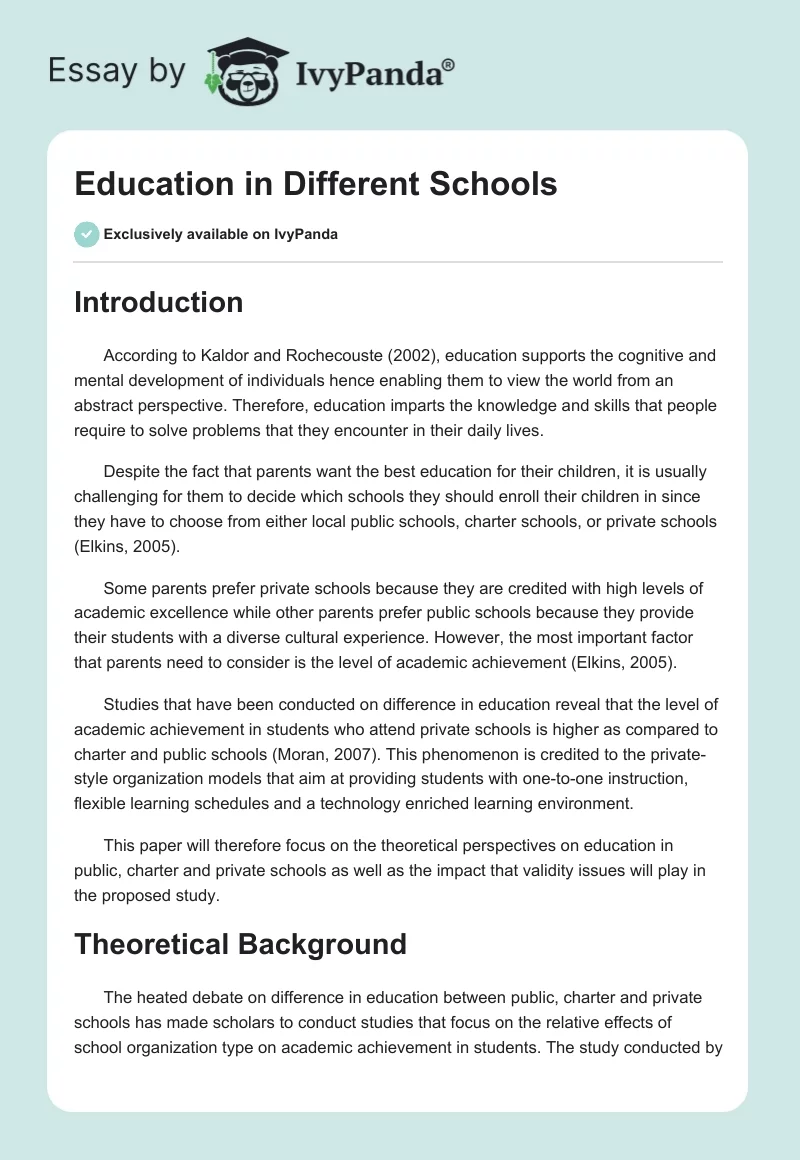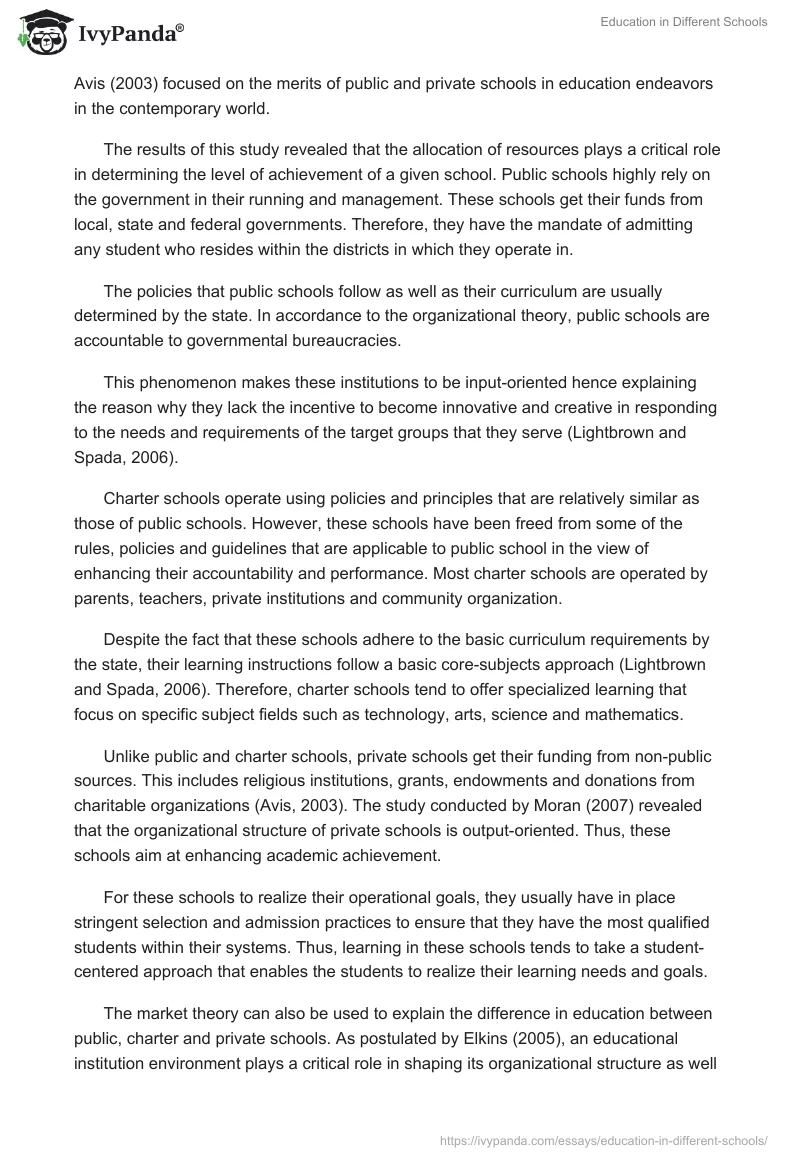Introduction
According to Kaldor and Rochecouste (2002), education supports the cognitive and mental development of individuals hence enabling them to view the world from an abstract perspective. Therefore, education imparts the knowledge and skills that people require to solve problems that they encounter in their daily lives.
Despite the fact that parents want the best education for their children, it is usually challenging for them to decide which schools they should enroll their children in since they have to choose from either local public schools, charter schools, or private schools (Elkins, 2005).
Some parents prefer private schools because they are credited with high levels of academic excellence while other parents prefer public schools because they provide their students with a diverse cultural experience. However, the most important factor that parents need to consider is the level of academic achievement (Elkins, 2005).
Studies that have been conducted on difference in education reveal that the level of academic achievement in students who attend private schools is higher as compared to charter and public schools (Moran, 2007). This phenomenon is credited to the private-style organization models that aim at providing students with one-to-one instruction, flexible learning schedules and a technology enriched learning environment.
This paper will therefore focus on the theoretical perspectives on education in public, charter and private schools as well as the impact that validity issues will play in the proposed study.
Theoretical Background
The heated debate on difference in education between public, charter and private schools has made scholars to conduct studies that focus on the relative effects of school organization type on academic achievement in students. The study conducted by Avis (2003) focused on the merits of public and private schools in education endeavors in the contemporary world.
The results of this study revealed that the allocation of resources plays a critical role in determining the level of achievement of a given school. Public schools highly rely on the government in their running and management. These schools get their funds from local, state and federal governments. Therefore, they have the mandate of admitting any student who resides within the districts in which they operate in.
The policies that public schools follow as well as their curriculum are usually determined by the state. In accordance to the organizational theory, public schools are accountable to governmental bureaucracies.
This phenomenon makes these institutions to be input-oriented hence explaining the reason why they lack the incentive to become innovative and creative in responding to the needs and requirements of the target groups that they serve (Lightbrown and Spada, 2006).
Charter schools operate using policies and principles that are relatively similar as those of public schools. However, these schools have been freed from some of the rules, policies and guidelines that are applicable to public school in the view of enhancing their accountability and performance. Most charter schools are operated by parents, teachers, private institutions and community organization.
Despite the fact that these schools adhere to the basic curriculum requirements by the state, their learning instructions follow a basic core-subjects approach (Lightbrown and Spada, 2006). Therefore, charter schools tend to offer specialized learning that focus on specific subject fields such as technology, arts, science and mathematics.
Unlike public and charter schools, private schools get their funding from non-public sources. This includes religious institutions, grants, endowments and donations from charitable organizations (Avis, 2003). The study conducted by Moran (2007) revealed that the organizational structure of private schools is output-oriented. Thus, these schools aim at enhancing academic achievement.
For these schools to realize their operational goals, they usually have in place stringent selection and admission practices to ensure that they have the most qualified students within their systems. Thus, learning in these schools tends to take a student-centered approach that enables the students to realize their learning needs and goals.
The market theory can also be used to explain the difference in education between public, charter and private schools. As postulated by Elkins (2005), an educational institution environment plays a critical role in shaping its organizational structure as well as the incentives that originate from the external environment that drive the productive process within the internal environment.
This fact explains why public schools are considered as being input-oriented while private schools are considered as being output-oriented. Using the market theory, it is evident that public schools specifically operate to meet the bureaucratic demands of the local, state and federal government. As such, these schools are governed by strict rules and policies that deter them from being innovative and creative in their operation.
This fact thus explains the reasons why performance in public schools has been deteriorating over time. For instance, learning in most public schools is teacher-centered. Therefore, it is the teacher who leads the teaching and learning process to meet the outcomes of the set curriculum (Lightbrown and Spada, 2006).
However, learning in private schools is student-centered. In addition to meeting the learning needs of the students, this approach increases their participation and interaction within and outside the classroom. It is such desired results that encourage parents in private schools to pay high tuition fees to enable their children to get the desired standard of education.
According to Vygotsky’s social development theory, the environment and society that surrounds individuals play an important role in their development (Lightbrown and Spada, 2006). Unlike in private schools, public schools comprise of students who come from varied cultures and backgrounds.
Therefore, there are parents who prefer to enroll their children in these schools so that they can enhance their cognitive and mental development in addition to normal learning.
Validity
In any research study, it is critical for researchers to ensure that the results that have been arrived at are valid and reliable. As Hammond (2001) asserted, experimental studies are conducted to determine the cause-and-effect relationship that exists between the study variables.
The concept of internal validity comes about when researchers expound on the relationship that might be present between the independent and dependent variables of a given study. The main purpose of conducting internal validity tests is to determine how well a research study has been conducted with regards to confounding effects (Hammond, 2001).
Confounding comes about when two or more independent variables are operational at a given time. Thus, a study is considered to have high internal validity if a researcher is in a position of choosing one alternative over the other available choices with a high level of confidence.
This enables the researcher to easily conclude that the observable changes in the dependent variables are as a result of the manipulations that originate from the independent variables.
While conducting a study, researchers use a sample of the target population. Therefore, it is essential for the researchers to ensure that the results that the inferences to the results of their studies can be easily generalized to the target population.
This makes it necessary for researchers to conduct external validity tests. Unlike in internal validity where the aim is to determine the relationship that exists between the study variables, external validity tests are conducted to determine the relationship that might be present between the study sample group and the target population.
It is due to this fact that Boscolo (2007) defined external validity as the ease at which the theory and data from one setting can be applied to another setting.
Research studies are guided by specific theories. At the end of a given study, it is essential for a researcher to determine to what extent the inferences of the study results can be made from the operationalization of the theoretical constructs on which these operations were actually based upon (Avis, 2003).
This concept is referred to as construct validity and is relatively similar to the concept of external validity in the sense that both these tests are based on the generalization of the results. However, while external validity focuses on the generalization of the results to the target population, construct validity focuses on the generalization of the results to the applied theory.
From practice, there are factors that act as threats to the internal and external validity of a given study. In an event where the internal validity of a given study is threatened, it will be difficult to state with confidence the relationship that might be present between the independent and dependent variables hence making it difficult for a researcher to arrive at the correct conclusion of the study.
On the other hand, threats to external validity affect the ease at which the results of a given study can be used to explain the trends that are present within the target population.
This can be brought about by some unanticipated events that might have occurred either in the sample or target population in the course of the study. At the same time, changes in the dependent variables that come about as a result of normal development can act as a threat to the generalizability of the results.
Validity and reliability issues will play a critical role in the current study. By conducting internal validity tests, it will be possible to determine whether a relationship exists between the dependent and independent variables of this study. Through external validity tests, it will be possible to determine whether the results of this study can be generalized to the target student population.
Finally, through construct validity, one will be able to determine whether the constructs of this study support the theories that had been put forward to support the study. With these considerations, conclusions as to whether the study will be valid and reliable will be arrived at.
Conclusion
The debate on the difference in education has developed mixed reactions among scholars. From the theories that have been presented in this paper, it is evident that organization structure, social interaction, and economic viability play a significant role in increasing the level of achievement in educational institutions.
Therefore, the fact that private schools have strong organizational structures and culture explains why they perform better as compared to charter and public schools. However, to support this claim, it will be critical for the proposed study to be reliable and valid to support and explain the trends that are present within the target student population.
References
Avis, J. (2003). ‘Re-thinking trust in a performative culture: the case of education’. Journal of Educational Policy, 18, (3), 315-332.
Boscolo, P. (2007). Improving the quality of students’ academic writing: An intervention study. Studies in Higher Education, 32(4), 419-438
Elkins, J. (2005). Inclusive education in Queensland: where are we going and how will we get there? Social Alternatives, 24(4), 45-49
Hammond, J. (2001). “Scaffolding and language”, in J. Hammond (ed.), Scaffolding: teaching and learning in language and literacy education, Primary English Teaching Association, Newtown, N.S.W. pp. 15 – 30.
Kaldor, S., & Rochecouste, J. (2002). General academic writing and discipline specific academic writing. Australian review of applied linguistics, 25(2), 29-47
Lightbrown, P. and Spada, N. (2006). How languages are learned, Oxford University Press: New York
Moran, A. (2007). Embracing inclusive teacher education. European Journal of Teacher Education, 30(2), 119-134


